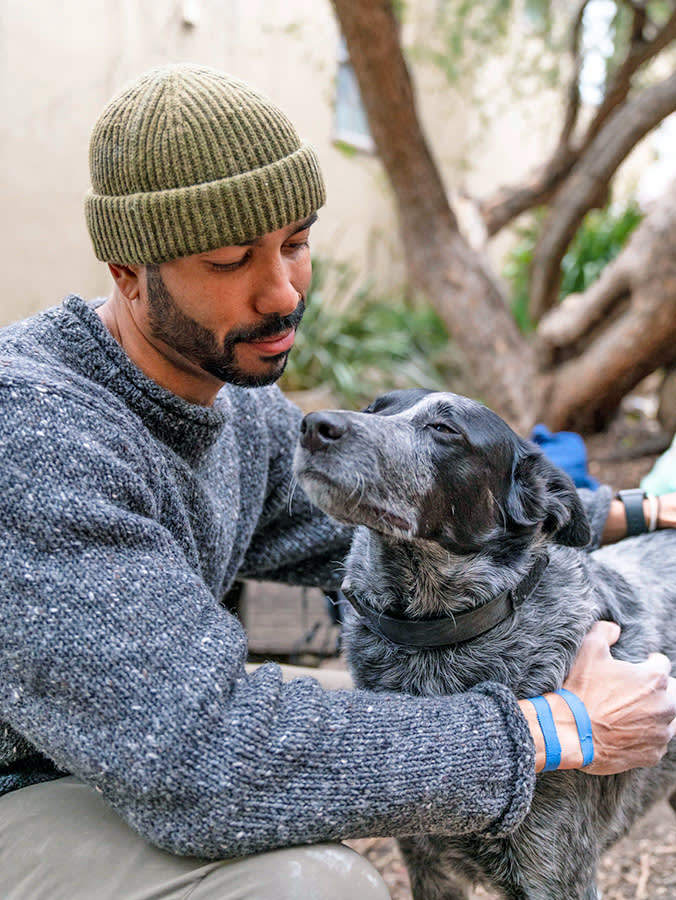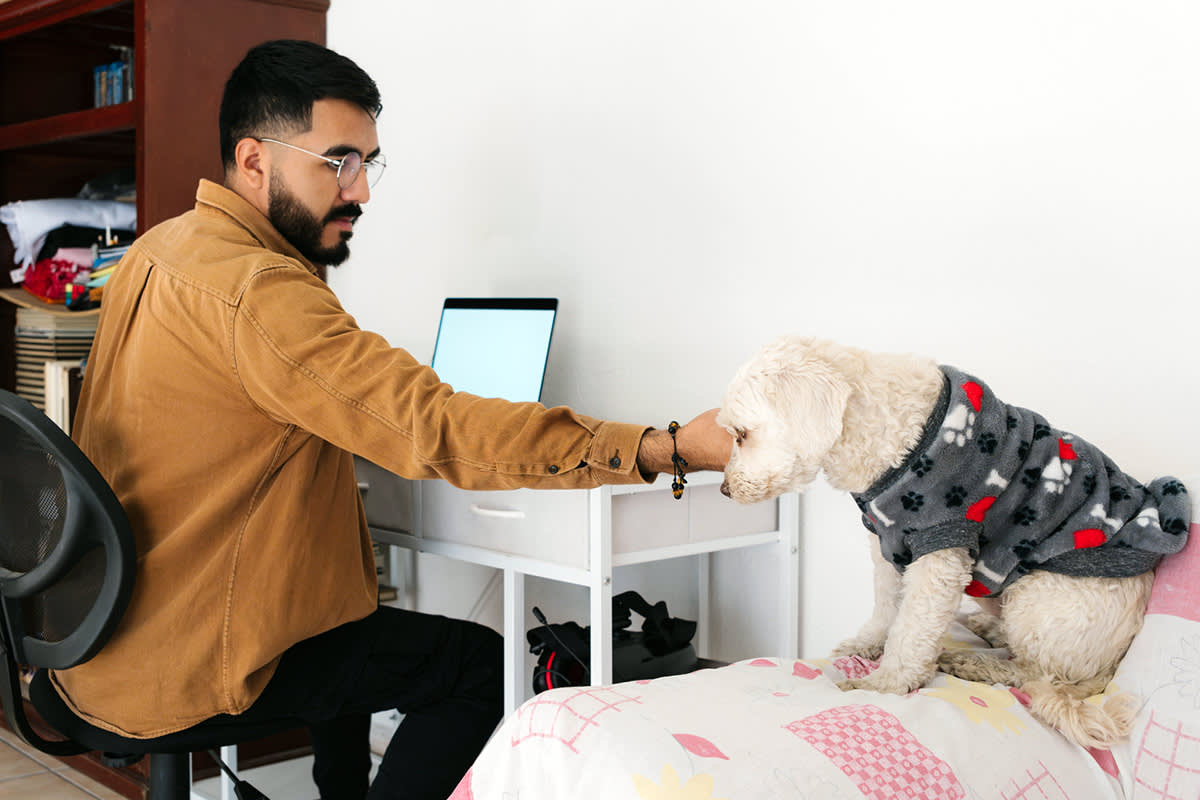How AI Will Change Your Relationship With Your Pet
Will this new technology help or hurt us?

Share Article
When we think about artificial intelligence (AI)opens in new tab, we might think of ChatGPT and the group photos your friends have turned into Studio Ghibli illustrations. While the debates about the ethics of AI copying famous filmmakers and the copyright lawsuits ramp up, we want to turn your attention to something else AI is working on: learning how to read the expressions of animals. The technology uses “landmarks” in animals’ faces, which are tied to muscle movements, to make a determination as to how they’re feeling.
Science reported in Februaryopens in new tab that several AI-facial-recognition studies are being conducted on dogs, cats, pigs, horses, and sheep. Most of the focus of AI research right now seems to be on farm animals and their welfare. Intellipigopens in new tab, created by University of the West of England Bristol (UWE) and Scotland’s Rural College (SRUC), used photos to monitor and analyze the facial expressions of pigs before eating and determined what customized meal to give them. If AI identified pain, emotional distress, or sickness, it would alert the farmer. All of this happened in less than a second, and Intellipig has a 97 percent accuracy rate.
Up until now, humans have been pinpointing animals’ pain through context. A limping animal is probably hurting, for example. A dog who isn’t eating and is whimpering is likely suffering from an illness. Scientists are hoping that, through getting an accurate read on facial and body language, AI will identify discomfort and pain in animals more accurately than humans do and improve the quality of their lives.
“The biggest hope is that AI might improve welfare for animals and underscore the problems with many of our current practices that negatively impact an animal’s welfare, such as close confinement and captivity, harsh training, and other stressors,” says Philip Tedeschi, co-director of the Institute for Animal Sentience and Protection and director emeritus and founder of the Institute for Human-Animal Connection. “The potential for AI to assist in predictive models in wildlife conservation might also be an improvement over the current old-fashioned perspectives, such as the North American Conservation Modelopens in new tab.” (The North American Conservation Model uses seven basic principles, or rules, to determine how wildlife is managed.)

So, when will we be able to learn more about our dogs and cats using the same tools?
AI tech for pups and kitties isn’t as advanced as other kinds — but it will be.
At some point, all pet parents have wished that our pups and kitties could tell us how they are doing or wondered what they want when they repeatedly scream-bark at us. AI is training on the faces of dogs and cats, but it’ll be a year, per University of Haifa computer scientist Anna Zamansky, before that technology is available.
“The more data you have, the more accurate your models will be,” Dr. Robert says. “However, the key is to define accuracy and be able to verify it.”
But there are a lot of dog breeds out there, and the AIs would need a lot of images of dogs to use for training. “The AI will need data from each breed and some measure of ground truth for each breed.” Dr. Lionel Robertopens in new tab, professor of Information and Robotics at the University of Michigan, tells Kinship. Zamansky’s team is planning on launching an AI app that allows users to scan their pet’s faces for 30 seconds and get a reading on their pain level. There is no concrete launch date for Zamansky’s app yet.
How could AI actually be useful to pet parents?
Right now, there isn’t a huge pool of dog images to pull from. Another bigger issue that feels more pressing: Will people pay for it? “Most pet owners would tell you they can already communicate with their pet at some level,” Dr. Robert says. In other words, AI wouldn’t necessarily be able to tell people what they don’t already know. For example, he says, AI wouldn’t be helpful if it told a pet parent that their dog who is barking by their food bowl is hungry. But it would be helpful if it could, for instance, distinguish a bark that means “I want a toy” from one that means “I want to go outside,” especially if the dog is giving no other physical cues.
Ideally, Dr. Roberts adds, pet parents would want to know if their dogs are happy, sad, stressed, and frustrated based on what their face is saying, which is not something AI is capable of yet. Dogs originally developed facial expressions to help communicate with humans; they have 20 facial expressions. While that’s not near as many as cats’ 276, it’s still enough to confuse a dog parent trying to decipher between “I’m sick” and “I just want attention, so I’m making big, round eyes at you.”
But will this technology reduce our connection with our pets?
“I think people are often lazy when it comes to their relationships and care of interpersonal communication.” Tedeschi says. “So, I think it is very possible that these tools increase the disconnect we already experience with each other, the living planet and other animals.” He goes on to say that if “people trust AI more than their own observations,” they might be come less tuned in to their pets’ body language, which could damage their bond with them over time.
“Just as our cell phones’ mapping features have resulted in atrophied sense of direction, an AI pet translator is likely to make us less attentive to subtle, real-time signals,” he adds. “Just put yourself in the animals’ paws in this hypothetical [situation] ... how would it feel to have your partner attempt to understand you through a tool of this sort?”
So, the real question isn’t can AI do it, but should AI do it? While there is a case for researchers using AI to improve the wellbeing of animals in general, do you really need to scan your pet’s face to read their emotions when you know from experience that they’re begging for an early dinner? Probably not. Pet parents might be better off waiting for an AI app that translates human speech into dog speech (if only!).

Alicia Kort
Alicia Kort is a writer and editor living in Brooklyn. Her work has appeared in Esquire, InStyle, Apartment Therapy, The Kitchn, Parade Home & Garden, Newsweek, Interview, Brooklyn magazine, and more. In her free time, she runs, reads, and spends time with her dog-nieces, Maya and Lady, and her cat-niece, Pepper. In her work, she focuses on pet behavior, pet-friendly spaces, and the lifestyle commerce space.
Related articles
![Young woman and her small white dog with a Whistle GPS.]()
5 Ways AI Will Change the Way You Parent Your Pet—Are You Ready?
Advancements in artificial intelligence are changing everything from the way we detect illnesses to how we keep our pets safe.
![Beagle dog barking outside in the grass.]()
New AI Technology Can Help Decode Dog Barks
The tech may help us better understand our pups.
![Man holds his fluffy white dog outside.]()
AI Discovers 5 Different Dog Personalities—Which One Is Your Pup?
A new study says your dog could fall into one of these categories based on their reactions to real-life events.
![a dog photographed by Sophie Gamand]()
Why I Used AI to Reconstruct Cropped Dog Ears
Vets everywhere agree that ear cropping is an unnecessary procedure that can lead to health problems. See how I gave these pups their ears back.
![Man looking at his orange cat at home.]()
This Free AI App Can Tell You What Your Cat’s Meows Mean—Supposedly
Meet MeowTalk, the app that translates your kitty’s screams into actual English.






